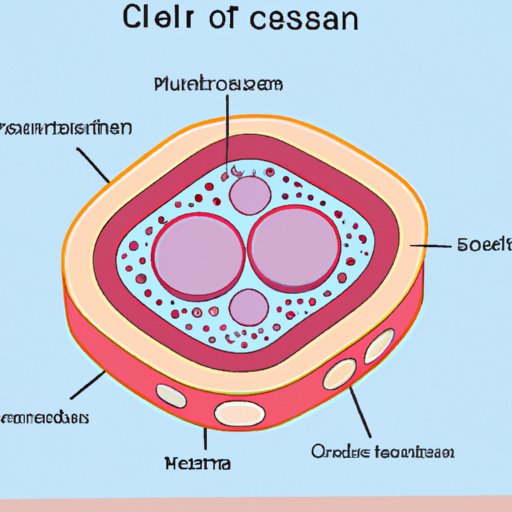Introduction
The word “cell” has been used in science for centuries, but what does it really mean? In its most basic form, a cell is the smallest structural unit of any living organism. It is composed of a variety of molecules and organelles that work together to perform specific functions. Cells play an essential role in all aspects of biology, from the development of organisms to the functioning of tissues and organs. This article will explore the science behind cells, from their structure and function to their role in organismal development and medicine.
Exploring the Science Behind Cellular Biology
Cellular biology is the study of cells, their structure, and how they interact with each other and their environment. A key part of this field is understanding the fundamentals of cell structure. Cells are typically composed of a plasma membrane, cytoplasm, nucleus, and various other organelles. These components work together to maintain the integrity of the cell and carry out essential metabolic processes.
Cells come in a variety of shapes and sizes, ranging from microscopic bacteria to complex mammalian cells. They can also be classified into two main categories: prokaryotic and eukaryotic cells. Prokaryotic cells lack a membrane-bound nucleus and organelles, while eukaryotic cells contain both. Animal and plant cells are examples of eukaryotic cells.
Examining the Role of Cells in Organismal Development
Cell differentiation is a process by which cells become specialized for different functions. During development, cells undergo a series of changes in their gene expression and morphology, allowing them to take on different roles in the body. Different types of cells can serve distinct purposes, such as forming tissues, organs, and even entire organisms.
Cells also play an important role in organismal development. Embryonic stem cells, for example, have the potential to differentiate into any type of cell in the body. By understanding how cells divide, migrate, and differentiate during development, scientists are able to better understand how organisms form and grow.

Investigating the Different Types of Cells in Nature
Prokaryotic and eukaryotic cells are the two major classes of cells found in nature. Prokaryotic cells are single-celled organisms such as bacteria, while eukaryotic cells are multi-celled organisms such as animals and plants. While they share many similarities, there are some key differences between the two.
Prokaryotic cells lack a membrane-bound nucleus and organelles, while eukaryotic cells contain both. Additionally, prokaryotic cells reproduce by binary fission, while eukaryotic cells reproduce through mitosis. Animal and plant cells are examples of eukaryotic cells, and they differ in terms of their structure and function.
Comparing Cell Structure and Function Across Species
Cell structure and function vary significantly across species. For example, plant cells have a rigid cell wall made of cellulose, while animal cells do not. Plant cells also contain chloroplasts, while animal cells do not. Additionally, plant cells use photosynthesis to produce energy, while animal cells rely on aerobic respiration.
These differences in cell structure and function allow organisms to live in different environments and perform different tasks. For example, plant cells are more suited for life on land, while animal cells are better adapted for life in water. Understanding these differences is key to understanding how cells evolved and how they continue to adapt to changing conditions.

Understanding How Cells Communicate with Each Other
In addition to their individual structure and function, cells also communicate with each other in order to coordinate activities throughout the body. This communication occurs through cell signaling, which involves the transmission of chemical signals between cells. These signals can trigger changes in cell behavior, such as cell growth, differentiation, and death.
In addition to cell signaling, cells also communicate with each other through intercellular communication. This process involves the exchange of information between cells through direct contact or through the release of molecules into the extracellular space. Intercellular communication is essential for the proper functioning of tissues and organs.

Analyzing the Impact of Cell Research on Modern Medicine
Cell research has had a profound impact on modern medicine. In recent decades, breakthroughs in cell research have enabled scientists to better understand the inner workings of cells and how they interact with their environment. This knowledge has enabled researchers to develop treatments for a variety of diseases, from cancer to Alzheimer’s.
Additionally, advances in cell research have enabled scientists to develop new technologies, such as stem cell therapy and tissue engineering. These technologies have the potential to revolutionize the way we treat diseases and injuries, and could potentially lead to cures for even the most intractable diseases.
Conclusion
The word “cell” has been used in science for centuries, but its true meaning and importance only become apparent when one looks at the science behind it. Cells are the building blocks of life, and they play an essential role in all aspects of biology, from development to medicine. Through a better understanding of cell structure, function, and communication, scientists are able to uncover new insights into how organisms form and how diseases can be treated.
(Note: Is this article not meeting your expectations? Do you have knowledge or insights to share? Unlock new opportunities and expand your reach by joining our authors team. Click Registration to join us and share your expertise with our readers.)
